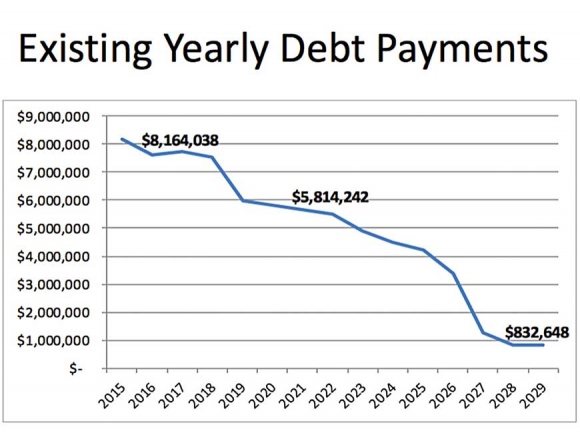Work begins on Haywood County budget
 Haywood County’s debt is projected to drop dramatically over the coming years. Haywood County photo
Haywood County’s debt is projected to drop dramatically over the coming years. Haywood County photo
Haywood County’s financial position remains strong ahead of talks about next year’s budget, but a host of challenges will test commissioners’ resolve to keep spending low and fund balance high.
“We’re meeting our obligations by not spending more than we’re bringing in,” Haywood County Manager Bryant Morehead told commissioners on Feb. 17.
Since 2013, the county’s general fund has grown from $70.2 million to $79.7 million in 2019. Morehead reported fiscal year 2019 expenditures of $80,561,541 and revenues of $83,279,099, but the FY 2020 budget, which ends on June 30, was amended to $89.9 million.
Perhaps the county’s biggest success over the past 15 years is in rebuilding fund balance, which was a dangerously low 11.58 percent of expenditures in 2006 but has since grown to a healthy 37.32 percent.
Yearly debt payments were more than $8 million a year in 2015, but have since declined substantially. In the current fiscal year, debt payments will amount to $5.8 million, but over the next three years that number will drop by about $150,000 a year.
Beginning in 2023, larger chunks of debt will be retired and payments will drop to less than $5 million a year. By 2026, they’ll be less than $3.5 million a year, with all debt retired by 2029 — if commissioners don’t incur any more in the interim.
Related Items
If they do, at least they’ll be able to borrow at a good rate — in November 2018, Moody’s Investors Service upgraded the county’s credit rating to AAA. According to Moody’s, “Obligations rated as AA are considered to be high quality and are subject to very low credit risk.”
Specific reasons for that include “a healthy financial position, a manageable debt burden, and a low pension liability.”
There’s still room for improvement on that rating, but Morehead said there aren’t clearly quantifiable goals that the county can aim for to make the jump.
“They have an equation and part of it is fund balance, but they also look at your economy,” he said. “One of the things that hurts us is we don’t have a lot of sites for economic development so we’re kind of behind the eight ball on that.”
Real and personal property taxes are coming in ahead of projected levels, as are motor vehicle taxes and sales taxes, which were budgeted at a 7 percent increase over last year but are currently hovering around 10 percent.
Health insurance spending has ranged from a recent low of $4.2 million in 2014 to a high of $10.1 million in this most recent budget year, but the change from Crescent to Aetna seems to be working right now, and only minimal increases are projected for next year.
“These are probably the best numbers as a commissioner I’ve ever seen,” said Commissioner Kevin Ensley.
With all that being said, commissioners must now grapple with the requests that will inevitably pop up once department budgets become available.
Total employment by the county has dropped from 9.42 employees per 1,000 population in 2006 to 8.4 employees per 1,000 residents in the current year, but that could change, as Morehead said he expects requests for several new positions in the Sheriff’s office as well as the Department of Health and Human Services.
How much employees are paid has been a recent topic of budget discussions that will again emerge; cost of living allowances began in 2016 but were skipped 2017 and then reinstituted in 2018, 2019 and 2020 but have never really kept pace with increases in the consumer price index.
Then there’s the usual round of vehicle replacements and fleet maintenance, and the replacement of aging IT equipment.
Those items, however, pale in comparison to a number of proposed capital projects that would cause the county to incur more long-term debt, making that credit rating all the more important.
Proposed are a new EMS base for the Clyde area, and depending on the results of a forthcoming study the potential expansion of the county detention center. A longstanding request for resources by Haywood County’s library system could finally gain some traction this year as well.
Commissioner Kirk Kirkpatrick pushed for renovations or construction, and Commissioner Kevin Ensley directed Morehead to begin looking at options and price tags.
“I think we’ve put it off too long,” Ensley said.
While the county won’t be able to pay for the capital project requests solely with fund balance, some of it could be used for initial architectural and engineering fees related to those projects.
“To me, when we’re sitting on that much fund balance, that’s our people’s money,” Kirkpatrick said. “We want a healthy fund balance, but not overly healthy.”
Another issue with which commissioners will have to deal — this year — is the impending move of Haywood County Schools’ administration from the old hospital, which is being converted to affordable housing for veterans and the elderly.
“We know the clock’s ticking, and we’ve got to help find them a home,” said Morehead.
The Feb. 17 meeting was only the initial foray into what will as usual be an extended process involving substantial public input. On April 20, commissioners will hold another work session, this one dealing specifically with the budgetary needs of the county’s school system. On May 4, another work session will be held, delving deeper into departmental budgets.
The manager’s budget — a solid final draft of proposed changes — will be submitted to commissioners on May 18. After that, a public hearing will be held on May 26, with possible budget adoption scheduled for the board’s regular meeting on June 1.
Per state law, budgets must be passed by June 30, leaving Haywood commissioners plenty of time if things don’t go exactly as planned.









